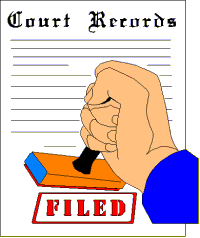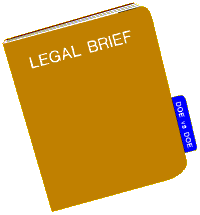Bankruptcy Timeline
Caution: This
timeline does not include all bankruptcy events. It is a
summary description of bankruptcy and may not be accurate under all
circumstances. You should consult a qualified attorney to see
how the law will apply to your situation.
Who or what is a debtor? The debtor is the person or
other entity that has filed the bankruptcy, and owes money to the
creditors. [11 USC §101(13)] |
|
BEFORE
FILING
|
|
 |
|
|
 |
|
|
 |
Bankruptcy
Filed |
 |
|
Commencement of Case
A voluntary bankruptcy is commenced by the filing of a petition
with the Bankruptcy Court requesting protection from creditors under
Chapter 7 or Chapter 13. A husband and wife may file one
petition together and commence a joint case. [11
USC §301, 11 USC §302, 11
USC §101(42), Rule 1002 FRBP]
|
| |
Filing fee due
In both Chapter 7 and Chapter 13, the filing fee must accompany
the petition which starts the case, unless an application to pay the
fees in installments is granted. [Rule
1002(b) FRBP]
|
|
|
List of creditors must be filed
In both Chapter 7 and Chapter 13, the petition must also be
accompanied by a list of the names and addresses of the debtor's
creditors. [Rule 1007(a) FRBP]
|
|
|
Statement of Social Security Number must be filed
In both Chapter 7 and Chapter 13, the petition must also be
accompanied by a verified statement that sets out the debtor's
social security number. [Rule
1007(f) FRBP]
|
|
 |
15 Days after
Bankruptcy Filed |
|
|
Schedules must be filed
In both Chapter 7 and Chapter 13, schedules of assets and
liabilities, a schedule of current income and expenditures, a
schedule of executory contracts and unexpired leases, and a
statement of financial affairs must be filed within 15 days after
the bankruptcy was filed. [11
USC §521(a)(1), Rule 1007(b),
(c) FRBP]
|
|
|
Chapter 13: Plan must be filed
In Chapter 13, the Plan must also be filed within 15 days after
the Bankruptcy was filed. The plan provides for submission of future
income and the treatment of creditors, specifying when and how much
each kind of creditor will receive. [Rule
3015(b) FRBP]
|
|
 |
About 18 Days
after Bankruptcy
Filed |
 |
|
Court Mails Notice of Commencement of
Case
Approximately 18 days after the bankruptcy is filed, the court
mails a Notice of Commencement of Case to the debtor and to
the creditors included in the list of creditors.
The notice contains meeting date, deadlines for objections to
discharge and for filing Proofs of Claims.
The court's Automated
Information Line provides much of this information almost
immediately after the bankruptcy is filed.
|
|
 |
30 Days after
Bankruptcy Filed |
|
|
Chapter 7: Statement of Intention
regarding secured debt must be filed
Within 30 days after a Chapter 7 has been filed (or before the §
341 meeting if that is earlier), the debtor must file a Statement
of Intention regarding property secured by consumer debt.
That statement shall indicate whether the debtor intend to:
(1) reaffirm the debt and continue to make the payments remaining
obligated for the balance of the debt, (2) redeem the property by
immediately paying the value of the property, or (3) surrender the
property. [11
U.S.C. § 521(2)(A); Rule
1007(b)(2) FRBP]
A copy of the Statement of Intention must be served on the
trustee and the creditors named in the statement on or before the
filing of the statement. [Rule
1007(b)(2) FRBP]
|
 |
|
Chapter 13: Plan payment due.
The debtor in a Chapter 13 must start making his plan payments
within 30 days after the bankruptcy was filed. [11
USC §1326(a)(1)]
|
|
|
Chapter 13: Plan must be mailed.
Depending on local rules, the debtor or his attorney must mail a
copy of the Chapter 13 Plan to all creditors within a specified
time. The Arizona Bankruptcy Court local rule 2083-4 requires
that the plan be mailed within 30 days after the case commenced.
[Local
Rule 2083-4(g), US
Bankruptcy Court, District of Arizona]
|
|
 |
7 Days before 341
Meeting |
|
|
Provide copies of tax returns
Not later than 7 days before the date first set for the first
meeting of creditors, the debtor shall provide a copy of the
debtor's most recent Federal income tax return to the trustee and to
any creditors that have requested it. [11
U.S.C. § 521(e)(2)]
|
|
 |
About
6 Weeks after Bankruptcy
Filed |
 |
|
§ 341 Meeting (Creditor's Meeting)
Section 341 (the symbol "§" means section) of the
Bankruptcy code requires the Trustee to preside at a meeting of
creditors within a "reasonable time" after the filing
of the bankruptcy. [11 USC §341]
This meeting is usually held approximately six weeks after
Bankruptcy is filed. The meeting time and date is included in
the Notice of Commencement of Case mailed by
the court, and is available on the court's Automated
Information Line shortly after the case is filed.
Each debtor is required to attend this meeting and testify under
oath, but most creditors do not come to the meeting. The
failure of creditors to attend the meeting does not effect their
right to challenge the discharge in a Chapter 7 or to object to the
plan in a Chapter 13. If the debtor does not attend, the case
will be dismissed.
|
|
 |
30 Days after 341
Meeting |
|
|
Deadline to file objection to claim of exemption
If the Trustee or other party of interest objects to the debtor's
claim of exempt property, they must their objection within 30 days
after the 341 meeting. [Rule
4003(b) FRBP]
|
|
|
Chapter 7: Debtor must perform under the Statement of
Intention
In Chapter 7, the debtor must perform under the Statement
of Intention, and (1) reaffirm the secured debt and continue
to make the payments remaining obligated for the balance of the
debt, (2) redeem the property by immediately paying the value of the
property, or (3) surrendering the property. [11
U.S.C. § 521(a)(2)(B); but 11
U.S.C. § 521(a)(6) appears to specify a time of 45 days after
the meeting for the same action]
|
|
 |
60 Days after 341
Meeting |
 |
|
Chapter 7: Deadline for objection to discharge of a
particular debt under §523(c)
Creditors have until 60 days after the first date set for 341
meeting to file a complaint under 11
U.S.C. § 523(c). That section allows creditors to
object to the discharge of debts which were obtained by false
pretenses, a false representation, or actual fraud; debt from fraud
or defalcation while acting in a fiduciary capacity, embezzlement or
larceny; and debt for willful and malicious injury. [Rule
4007(c) FRBP]
This deadline applies to objections to discharge of:
Consumer debts owed to a single creditor and aggregating more
than
$500 (added by BAPCPA 10-17-05) for luxury goods or services
incurred by an individual debtor on or within 90 days before a
Chapter 7 bankruptcy [11
USC §523(a)(2)(C)(i)(I), 11
USC §1328(b)], and
Consumer debts owed to a single creditor and aggregating more
than
$500 (added by BAPCPA 10-17-05) for luxury goods or services
incurred by an individual debtor on or within 90 days before the
bankruptcy is filed are presumed to be nondischargeable in Chapter
7. [11
USC §523(a)(2)(C)(i)(I), 11
USC §1328(b)]
|
 |
|
Chapter 7: Deadline for objection to discharge of all debt
under §727(a)
Creditors have until 60 days after the first date set for 341
meeting to file a complaint under 11
U.S.C. § 727(a). That section allows object to the
discharge of all debts because of misconduct including transfer,
destruction or concealment of property; concealment, destruction,
falsification or failure to keep financial records; making false
statements; withholding information; failing to explain losses;
failure to respond to material questions; having received a
discharge in a prior case filed within the last 6 years. [Rule
4004(a) FRBP]
|
 |
|
Chapter 7: Deadline for U.S. Trustee or court to move to
dismiss case for "substantial abuse" under §707(b)
Until 60 days after the first date set for the 341
meeting, the U.S. Trustee or the court may move to dismiss a
case in which debts are primarily consumer debts if it finds that
the granting of relief would be a "substantial abuse" of
the provisions of Chapter 7. [Rule
1017(e) FRBP]
"Substantial abuse" was expanded by the Bankruptcy
Reform Act, which went into effect on October 17, 2005, to include a
Means Test which allows Chapter 7
only if a debtor has less income than the median for the state of
residence, or can pay less than 25% of his or her unsecured debt
from income remaining after meeting expenses over a 5 year period.
[11 USC §707(b)]
|
|
 |
More than 60 Days after 341
Meeting |
 |
|
Discharge entered in Chapter 7 case
Court rules require that the discharge be entered
"forthwith" after the expiration of the time for objecting
to discharge or moving to dismiss the case. The time for those
objections expires 60 days after the first date set for creditor's
meeting. [Rule
4004(c)(1) FRBP, Rule 4004(a)
FRBP, Rule 1017(e) FRBP]
The discharge is not absolute or final. The Trustee can ask that
the discharge be set aside if the debtor does not turn over
non-exempt property, if the debtor fails to perform other duties, or
if there were other matters pending which would result in the denial
of the discharge.
|
|
 |
90 Days after 341
Meeting |
|
|
Deadline for non-government creditors to file their Proofs of
Claim
A creditor, other than a governmental unit, must file its Proof
of Claim within 90 days after the after the first date set for
creditor's 341 meeting in order to share in payments from the
estate. [Rule 3002(c) FRBP]
|
|
 |
120 Days after
Bankruptcy Filed |
|
|
Final payment on filing fees due.
If the the Court allowed the debtor to pay the filing fees for a
Chapter 7 or Chapter 13 in payments, the final payment must be made
within 120 days after the filing of the bankruptcy. [Rule
1002(b) FRBP]
|
|
 |
180 Days after
Bankruptcy Filed |
|
|
Deadline for governmental unit to file Proof of Claim
A governmental unit, such as the Internal Revenue Service, must
file its Proof of Claim within 180 days after the
commencement of the case in order to share in payments from the
estate. [Rule 3002(c)(1) FRBP]
|
|
 |
180 Days after
Bankruptcy Filed |
|
|
Deadline for governmental unit to file Proof of Claim
A governmental unit, such as the Internal Revenue Service, must
file its Proof of Claim within 180 days after the
commencement of the case in order to share in payments from the
estate. [Rule 3002(c)(1) FRBP]
|
|
 |
3 to 5 years after
First Plan Payment |
 |
|
Length of payments under Chapter 13 Plan
Unless all allowed claims are paid sooner, plan payments must
continue for a minimum of the three-year period beginning on the
date that the first payment is due under the plan, or a maximum of a
five year period. [11
USC §1325(b)(1), 11
USC §1322(d)]
|
| |
Discharge entered in Chapter 13
Upon completion of plan payments the discharge in Chapter 13 is
entered. [11 USC §1328]
|
| |
 |
|
|
BEFORE
FILING
|